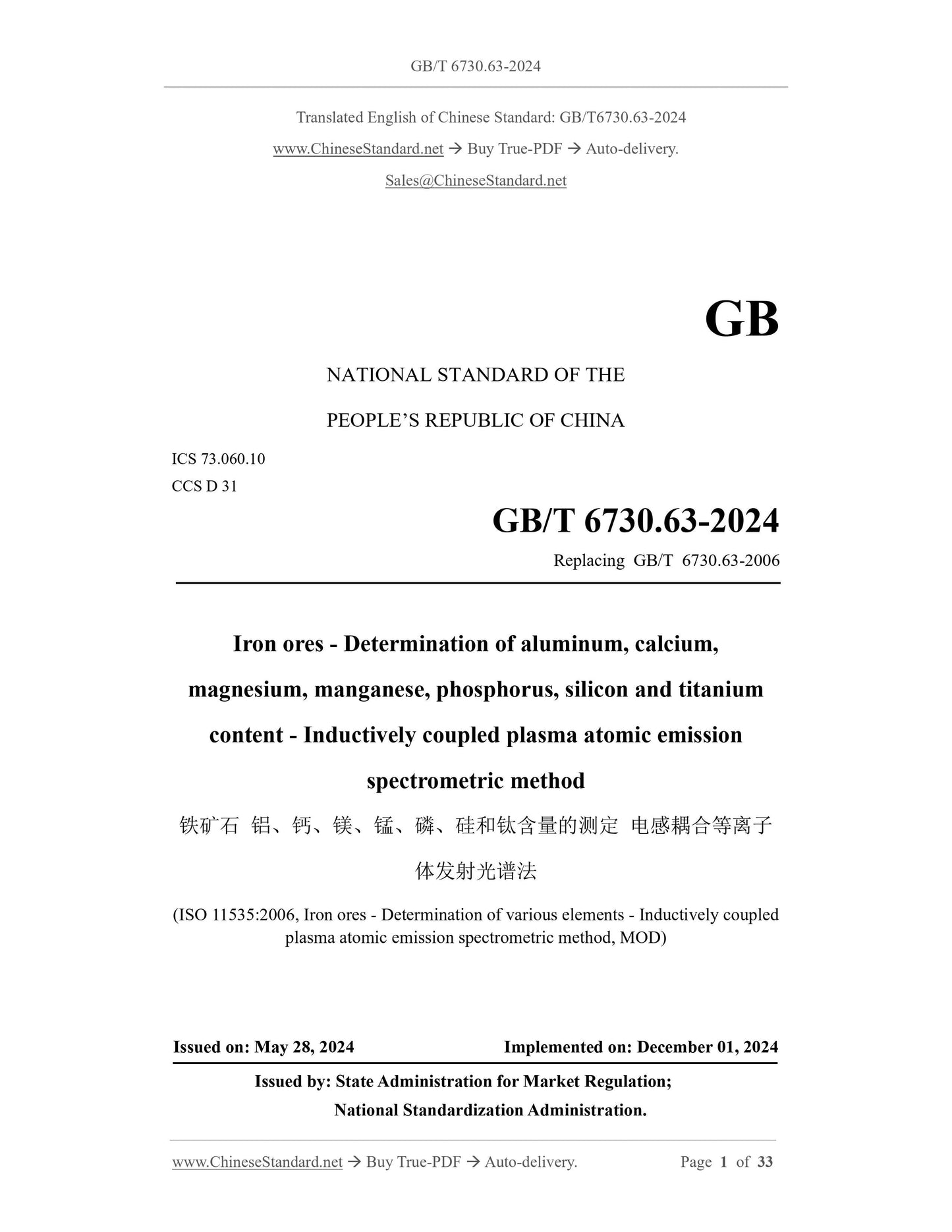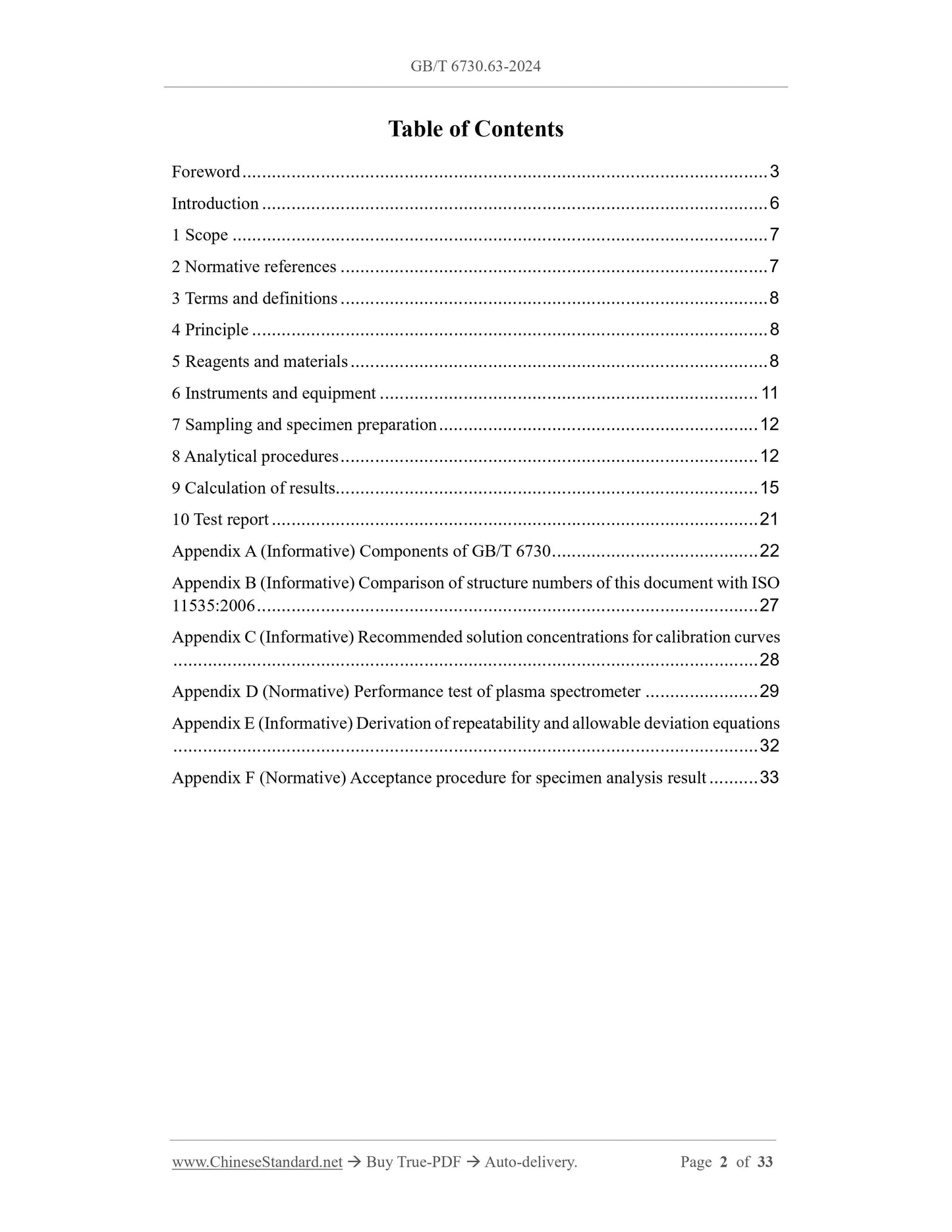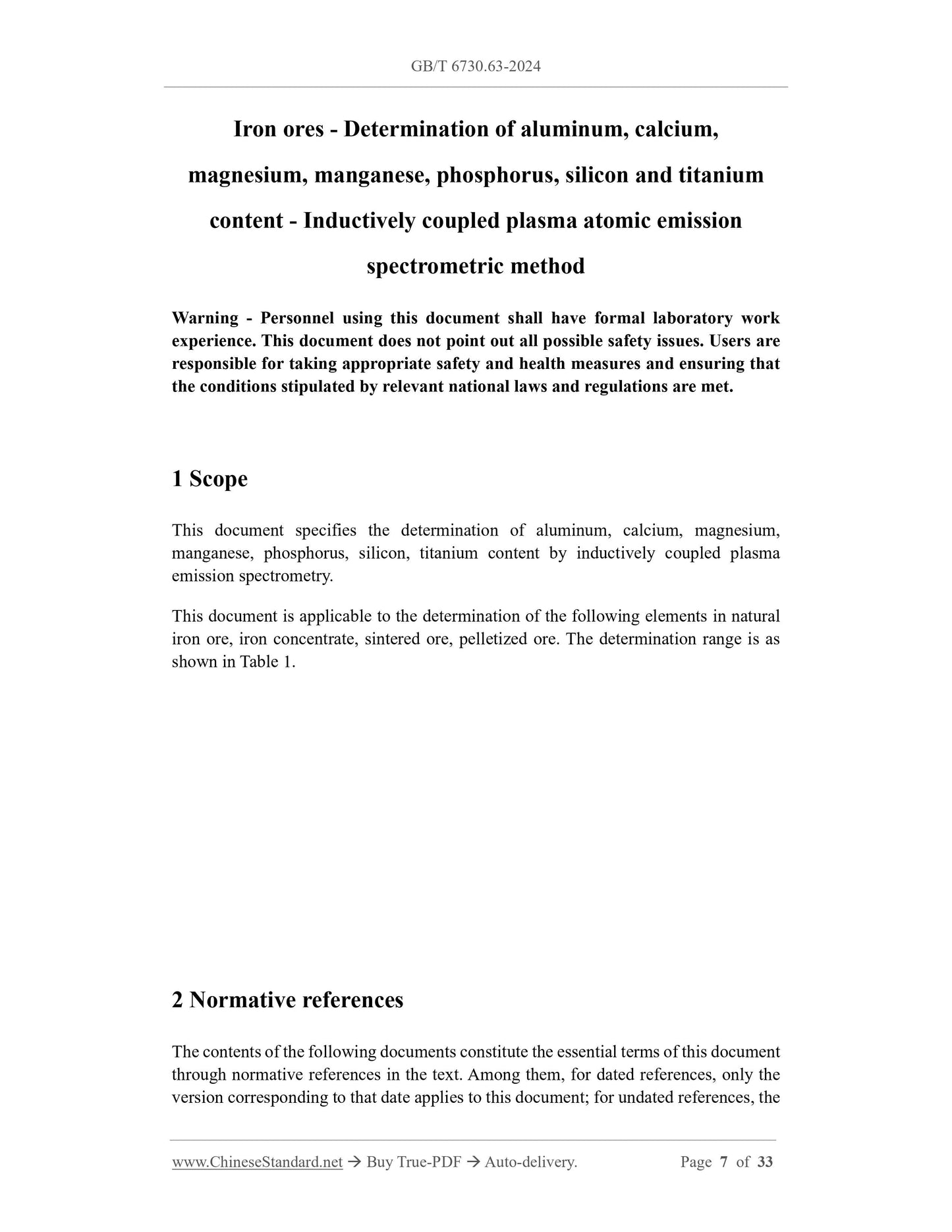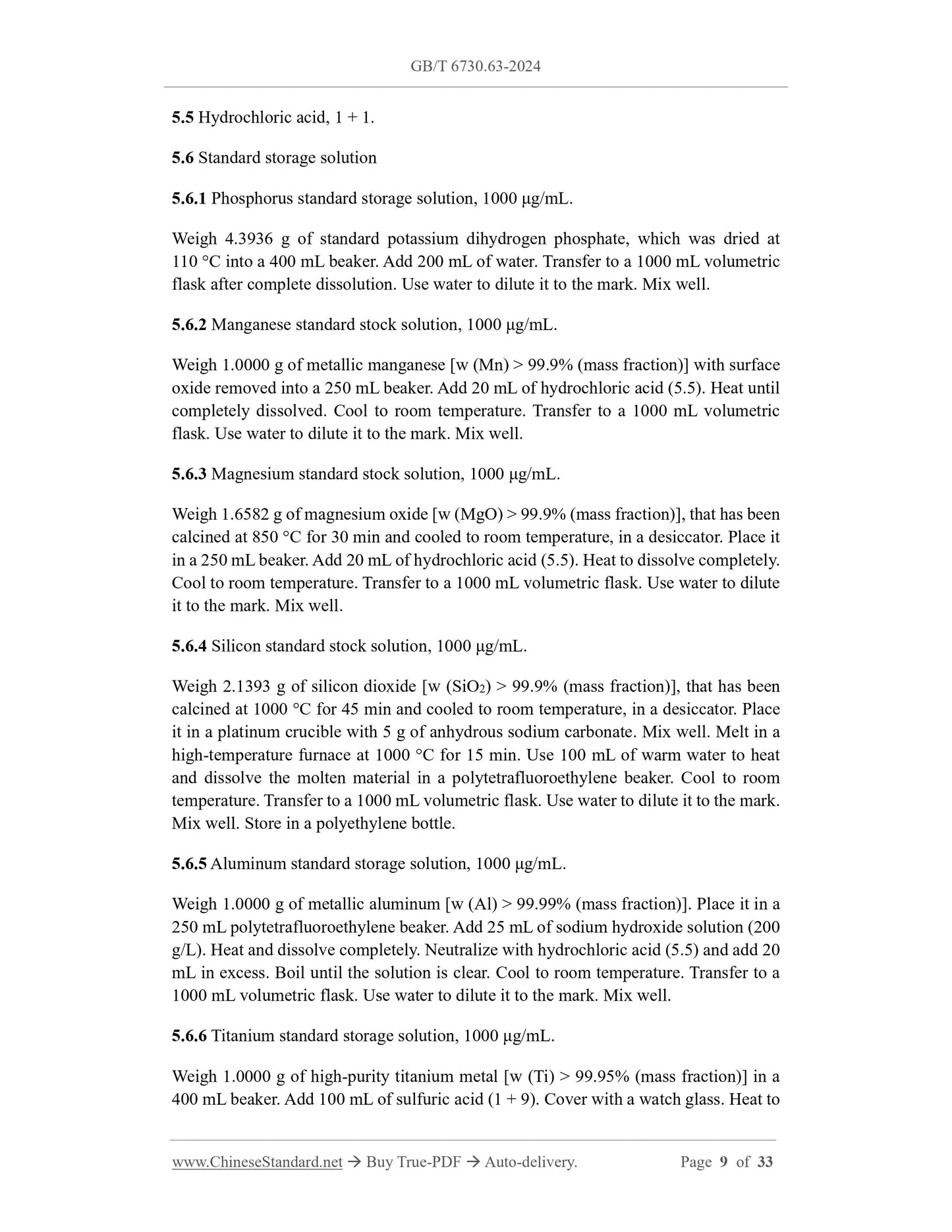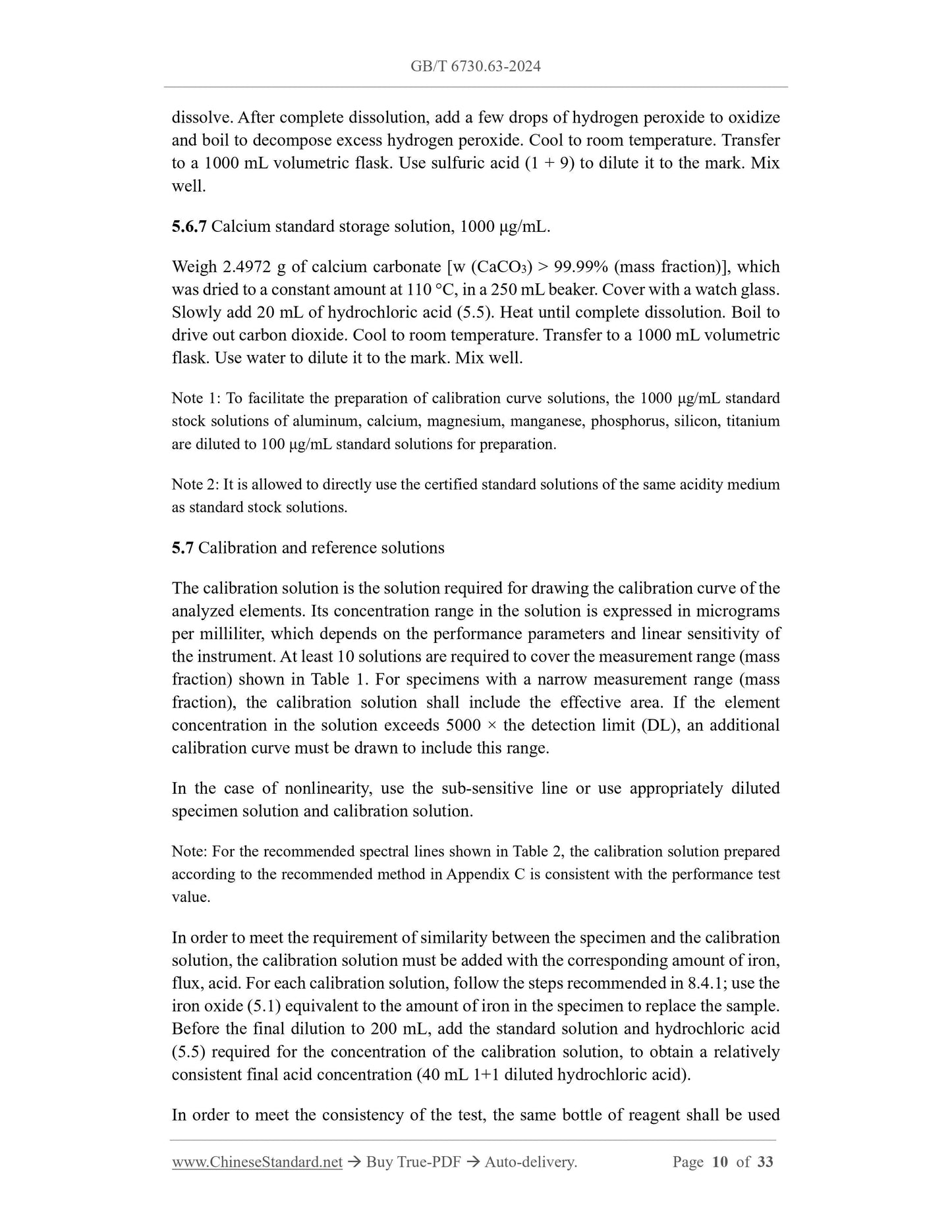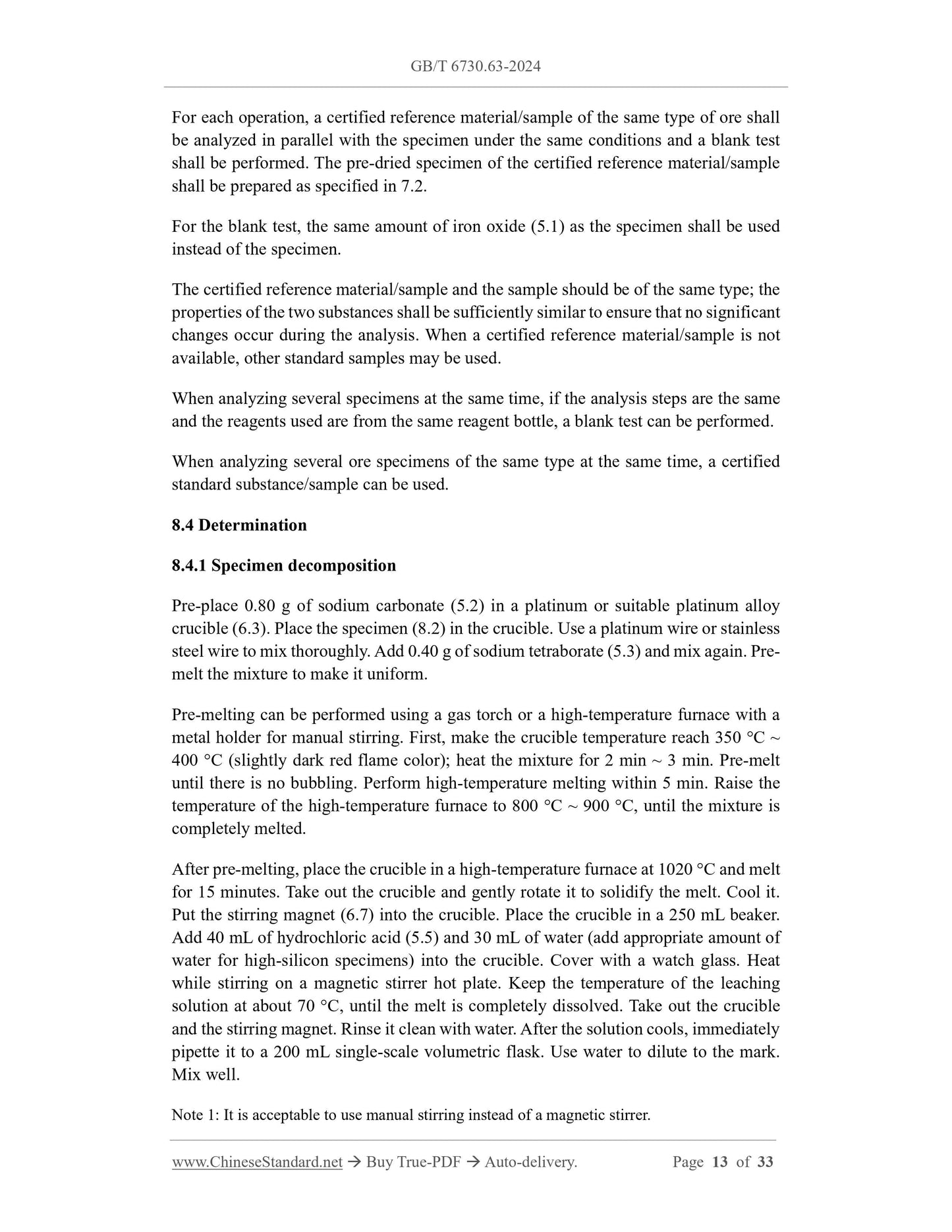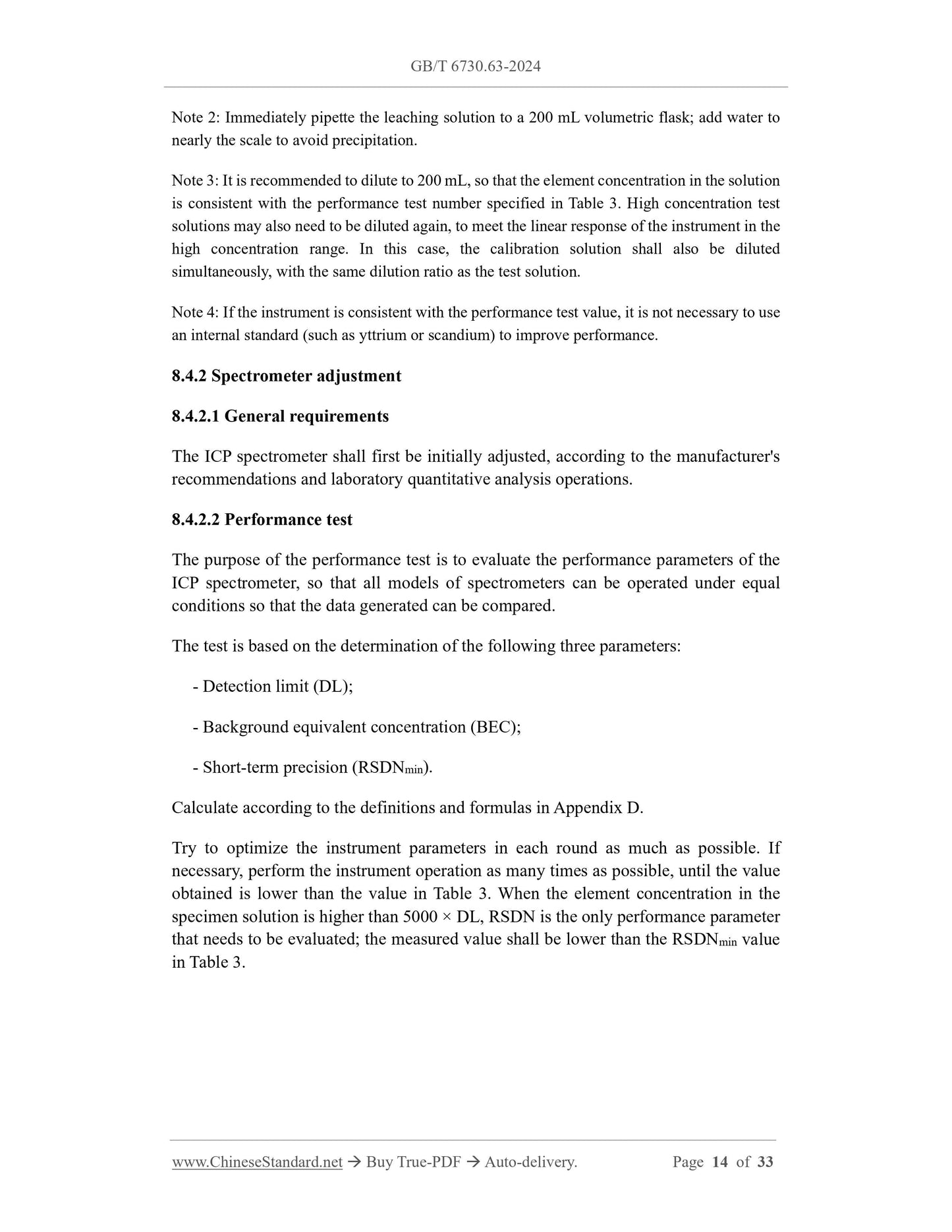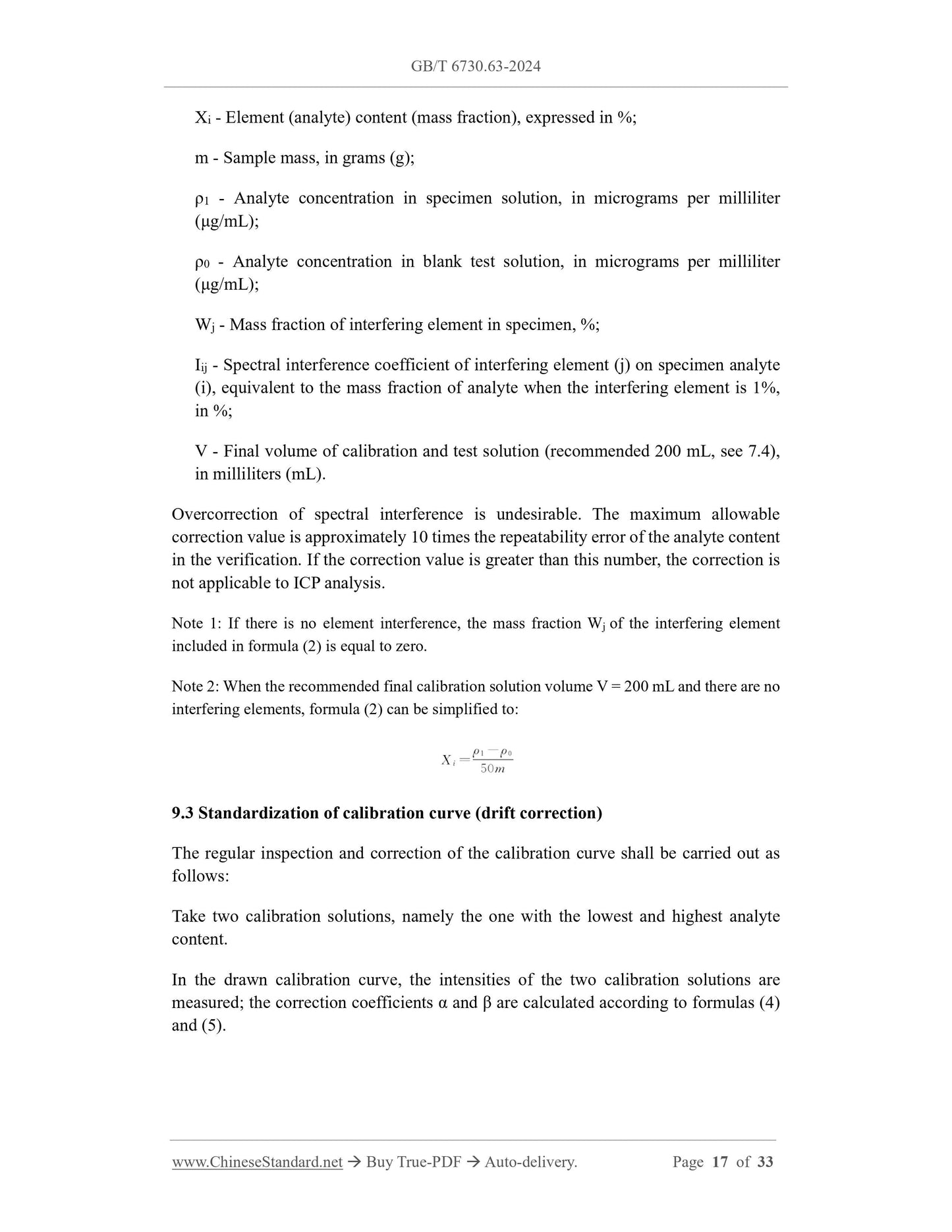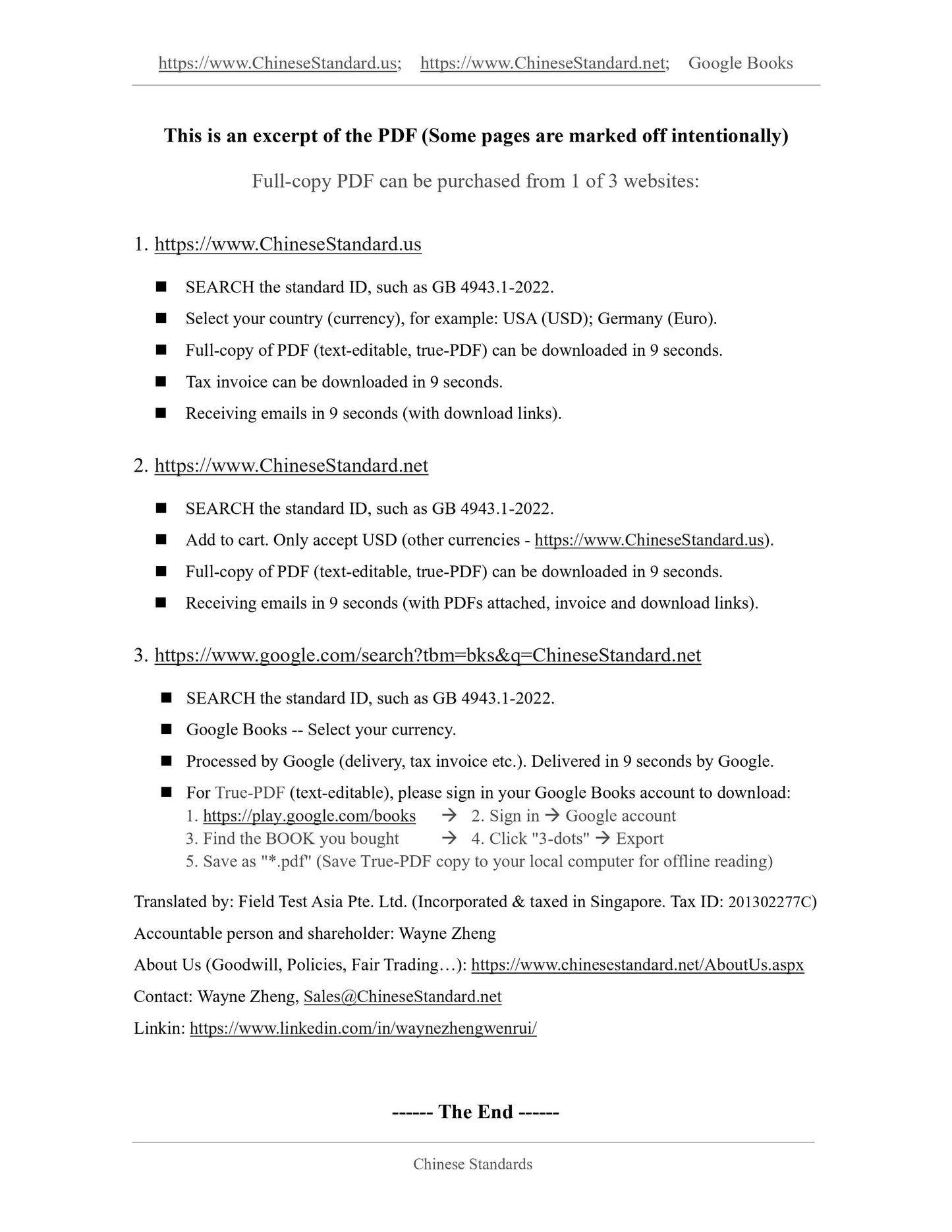1
/
of
9
PayPal, credit cards. Download editable-PDF and invoice in 1 second!
GB/T 6730.63-2024 English PDF (GBT6730.63-2024)
GB/T 6730.63-2024 English PDF (GBT6730.63-2024)
Regular price
$440.00 USD
Regular price
Sale price
$440.00 USD
Unit price
/
per
Shipping calculated at checkout.
Couldn't load pickup availability
Delivery: 3 seconds. Download true-PDF + Invoice.
Get QUOTATION in 1-minute: Click GB/T 6730.63-2024
Historical versions: GB/T 6730.63-2024
Preview True-PDF (Reload/Scroll if blank)
GB/T 6730.63-2024: Iron ores - Determination of aluminum, calcium, magnesium, manganese, phosphorus, silicon and titanium content - Inductively coupled plasma atomic emission spectrometric method
GB/T 6730.63-2024
GB
NATIONAL STANDARD OF THE
PEOPLE’S REPUBLIC OF CHINA
ICS 73.060.10
CCS D 31
Replacing GB/T 6730.63-2006
Iron ores - Determination of aluminum, calcium,
magnesium, manganese, phosphorus, silicon and titanium
content - Inductively coupled plasma atomic emission
spectrometric method
(ISO 11535:2006, Iron ores - Determination of various elements - Inductively coupled
plasma atomic emission spectrometric method, MOD)
ISSUED ON: MAY 28, 2024
IMPLEMENTED ON: DECEMBER 01, 2024
Issued by: State Administration for Market Regulation;
National Standardization Administration.
Table of Contents
Foreword ... 3
Introduction ... 6
1 Scope ... 7
2 Normative references ... 7
3 Terms and definitions ... 8
4 Principle ... 8
5 Reagents and materials ... 8
6 Instruments and equipment ... 11
7 Sampling and specimen preparation ... 12
8 Analytical procedures ... 12
9 Calculation of results ... 15
10 Test report ... 21
Appendix A (Informative) Components of GB/T 6730 ... 22
Appendix B (Informative) Comparison of structure numbers of this document with ISO
11535:2006 ... 27
Appendix C (Informative) Recommended solution concentrations for calibration curves
... 28
Appendix D (Normative) Performance test of plasma spectrometer ... 29
Appendix E (Informative) Derivation of repeatability and allowable deviation equations
... 32
Appendix F (Normative) Acceptance procedure for specimen analysis result ... 33
Iron ores - Determination of aluminum, calcium,
magnesium, manganese, phosphorus, silicon and titanium
content - Inductively coupled plasma atomic emission
spectrometric method
Warning - Personnel using this document shall have formal laboratory work
experience. This document does not point out all possible safety issues. Users are
responsible for taking appropriate safety and health measures and ensuring that
the conditions stipulated by relevant national laws and regulations are met.
1 Scope
This document specifies the determination of aluminum, calcium, magnesium,
manganese, phosphorus, silicon, titanium content by inductively coupled plasma
emission spectrometry.
This document is applicable to the determination of the following elements in natural
iron ore, iron concentrate, sintered ore, pelletized ore. The determination range is as
shown in Table 1.
2 Normative references
The contents of the following documents constitute the essential terms of this document
through normative references in the text. Among them, for dated references, only the
version corresponding to that date applies to this document; for undated references, the
5.5 Hydrochloric acid, 1 + 1.
5.6 Standard storage solution
5.6.1 Phosphorus standard storage solution, 1000 μg/mL.
Weigh 4.3936 g of standard potassium dihydrogen phosphate, which was dried at
110 °C into a 400 mL beaker. Add 200 mL of water. Transfer to a 1000 mL volumetric
flask after complete dissolution. Use water to dilute it to the mark. Mix well.
5.6.2 Manganese standard stock solution, 1000 μg/mL.
Weigh 1.0000 g of metallic manganese [w (Mn) > 99.9% (mass fraction)] with surface
oxide removed into a 250 mL beaker. Add 20 mL of hydrochloric acid (5.5). Heat until
completely dissolved. Cool to room temperature. Transfer to a 1000 mL volumetric
flask. Use water to dilute it to the mark. Mix well.
5.6.3 Magnesium standard stock solution, 1000 μg/mL.
Weigh 1.6582 g of magnesium oxide [w (MgO) > 99.9% (mass fraction)], that has been
calcined at 850 °C for 30 min and cooled to room temperature, in a desiccator. Place it
in a 250 mL beaker. Add 20 mL of hydrochloric acid (5.5). Heat to dissolve completely.
Cool to room temperature. Transfer to a 1000 mL volumetric flask. Use water to dilute
it to the mark. Mix well.
5.6.4 Silicon standard stock solution, 1000 μg/mL.
Weigh 2.1393 g of silicon dioxide [w (SiO2) > 99.9% (mass fraction)], that has been
calcined at 1000 °C for 45 min and cooled to room temperature, in a desiccator. Place
it in a platinum crucible with 5 g of anhydrous sodium carbonate. Mix well. Melt in a
high-temperature furnace at 1000 °C for 15 min. Use 100 mL of warm water to heat
and dissolve the molten material in a polytetrafluoroethylene beaker. Cool to room
temperature. Transfer to a 1000 mL volumetric flask. Use water to dilute it to the mark.
Mix well. Store in a polyethylene bottle.
5.6.5 Aluminum standard storage solution, 1000 μg/mL.
Weigh 1.0000 g of metallic aluminum [w (Al) > 99.99% (mass fraction)]. Place it in a
250 mL polytetrafluoroethylene beaker. Add 25 mL of sodium hydroxide solution (200
g/L). Heat and dissolve completely. Neutralize with hydrochloric acid (5.5) and add 20
mL in excess. Boil until the solution is clear. Cool to room temperature. Transfer to a
1000 mL volumetric flask. Use water to dilute it to the mark. Mix well.
5.6.6 Titanium standard storage solution, 1000 μg/mL.
Weigh 1.0000 g of high-purity titanium metal [w (Ti) > 99.95% (mass fraction)] in a
400 mL beaker. Add 100 mL of sulfuric acid (1 + 9). Cover with a watch glass. Heat to
dissolve. After complete dissolution, add a few drops of hydrogen peroxide to oxidize
and boil to decompose excess hydrogen peroxide. Cool to room temperature. Transfer
to a 1000 mL volumetric flask. Use sulfuric acid (1 + 9) to dilute it to the mark. Mix
well.
5.6.7 Calcium standard storage solution, 1000 μg/mL.
Weigh 2.4972 g of calcium carbonate [w (CaCO3) > 99.99% (mass fraction)], which
was dried to a constant amount at 110 °C, in a 250 mL beaker. Cover with a watch glass.
Slowly add 20 mL of hydrochloric acid (5.5). Heat until complete dissolution. Boil to
drive out carbon dioxide. Cool to room temperature. Transfer to a 1000 mL volumetric
flask. Use water to dilute it to the mark. Mix well.
Note 1: To facilitate the preparation of calibration curve solutions, the 1000 μg/mL standard
stock solutions of aluminum, calcium, magnesium, manganese, phosphorus, silicon, titanium
are diluted to 100 μg/mL standard solutions for preparation.
Note 2: It is allowed to directly use the certified standard solutions of the same acidity medium
as standard stock solutions.
5.7 Calibration and reference solutions
The calibration solution is the solution required for drawing the calibration curve of the
analyzed elements. Its concentration range in the solution is expressed in micrograms
per milliliter, which depends on the performance parameters and linear sensitivity of
the instrument. At least 10 solutions are required to cover the measurement range (mass
fraction) shown in Table 1. For specimens with a narrow measurement range (mass
fraction), the calibration solution shall include the effective area. If the element
concentration in the solution exceeds 5000 × the detection limit (DL), an additional
calibration curve must be drawn to include this range.
In the case of nonlinearity, use the sub-sensitive line or use appropriately diluted
specimen solution and calibration solution.
Note: For the recommended spectral lines shown in Table 2, the calibration solution prepared
according to the recommended method in Appendix C is consistent with the performance test
value.
In order to meet the requirement of similarity between the specimen and the calibration
solution, the calibration solution must be added with the corresponding amount of iron,
flux, acid. For each calibration solution, follow the steps recommended in 8.4.1; use the
iron oxide (5.1) e...
Get QUOTATION in 1-minute: Click GB/T 6730.63-2024
Historical versions: GB/T 6730.63-2024
Preview True-PDF (Reload/Scroll if blank)
GB/T 6730.63-2024: Iron ores - Determination of aluminum, calcium, magnesium, manganese, phosphorus, silicon and titanium content - Inductively coupled plasma atomic emission spectrometric method
GB/T 6730.63-2024
GB
NATIONAL STANDARD OF THE
PEOPLE’S REPUBLIC OF CHINA
ICS 73.060.10
CCS D 31
Replacing GB/T 6730.63-2006
Iron ores - Determination of aluminum, calcium,
magnesium, manganese, phosphorus, silicon and titanium
content - Inductively coupled plasma atomic emission
spectrometric method
(ISO 11535:2006, Iron ores - Determination of various elements - Inductively coupled
plasma atomic emission spectrometric method, MOD)
ISSUED ON: MAY 28, 2024
IMPLEMENTED ON: DECEMBER 01, 2024
Issued by: State Administration for Market Regulation;
National Standardization Administration.
Table of Contents
Foreword ... 3
Introduction ... 6
1 Scope ... 7
2 Normative references ... 7
3 Terms and definitions ... 8
4 Principle ... 8
5 Reagents and materials ... 8
6 Instruments and equipment ... 11
7 Sampling and specimen preparation ... 12
8 Analytical procedures ... 12
9 Calculation of results ... 15
10 Test report ... 21
Appendix A (Informative) Components of GB/T 6730 ... 22
Appendix B (Informative) Comparison of structure numbers of this document with ISO
11535:2006 ... 27
Appendix C (Informative) Recommended solution concentrations for calibration curves
... 28
Appendix D (Normative) Performance test of plasma spectrometer ... 29
Appendix E (Informative) Derivation of repeatability and allowable deviation equations
... 32
Appendix F (Normative) Acceptance procedure for specimen analysis result ... 33
Iron ores - Determination of aluminum, calcium,
magnesium, manganese, phosphorus, silicon and titanium
content - Inductively coupled plasma atomic emission
spectrometric method
Warning - Personnel using this document shall have formal laboratory work
experience. This document does not point out all possible safety issues. Users are
responsible for taking appropriate safety and health measures and ensuring that
the conditions stipulated by relevant national laws and regulations are met.
1 Scope
This document specifies the determination of aluminum, calcium, magnesium,
manganese, phosphorus, silicon, titanium content by inductively coupled plasma
emission spectrometry.
This document is applicable to the determination of the following elements in natural
iron ore, iron concentrate, sintered ore, pelletized ore. The determination range is as
shown in Table 1.
2 Normative references
The contents of the following documents constitute the essential terms of this document
through normative references in the text. Among them, for dated references, only the
version corresponding to that date applies to this document; for undated references, the
5.5 Hydrochloric acid, 1 + 1.
5.6 Standard storage solution
5.6.1 Phosphorus standard storage solution, 1000 μg/mL.
Weigh 4.3936 g of standard potassium dihydrogen phosphate, which was dried at
110 °C into a 400 mL beaker. Add 200 mL of water. Transfer to a 1000 mL volumetric
flask after complete dissolution. Use water to dilute it to the mark. Mix well.
5.6.2 Manganese standard stock solution, 1000 μg/mL.
Weigh 1.0000 g of metallic manganese [w (Mn) > 99.9% (mass fraction)] with surface
oxide removed into a 250 mL beaker. Add 20 mL of hydrochloric acid (5.5). Heat until
completely dissolved. Cool to room temperature. Transfer to a 1000 mL volumetric
flask. Use water to dilute it to the mark. Mix well.
5.6.3 Magnesium standard stock solution, 1000 μg/mL.
Weigh 1.6582 g of magnesium oxide [w (MgO) > 99.9% (mass fraction)], that has been
calcined at 850 °C for 30 min and cooled to room temperature, in a desiccator. Place it
in a 250 mL beaker. Add 20 mL of hydrochloric acid (5.5). Heat to dissolve completely.
Cool to room temperature. Transfer to a 1000 mL volumetric flask. Use water to dilute
it to the mark. Mix well.
5.6.4 Silicon standard stock solution, 1000 μg/mL.
Weigh 2.1393 g of silicon dioxide [w (SiO2) > 99.9% (mass fraction)], that has been
calcined at 1000 °C for 45 min and cooled to room temperature, in a desiccator. Place
it in a platinum crucible with 5 g of anhydrous sodium carbonate. Mix well. Melt in a
high-temperature furnace at 1000 °C for 15 min. Use 100 mL of warm water to heat
and dissolve the molten material in a polytetrafluoroethylene beaker. Cool to room
temperature. Transfer to a 1000 mL volumetric flask. Use water to dilute it to the mark.
Mix well. Store in a polyethylene bottle.
5.6.5 Aluminum standard storage solution, 1000 μg/mL.
Weigh 1.0000 g of metallic aluminum [w (Al) > 99.99% (mass fraction)]. Place it in a
250 mL polytetrafluoroethylene beaker. Add 25 mL of sodium hydroxide solution (200
g/L). Heat and dissolve completely. Neutralize with hydrochloric acid (5.5) and add 20
mL in excess. Boil until the solution is clear. Cool to room temperature. Transfer to a
1000 mL volumetric flask. Use water to dilute it to the mark. Mix well.
5.6.6 Titanium standard storage solution, 1000 μg/mL.
Weigh 1.0000 g of high-purity titanium metal [w (Ti) > 99.95% (mass fraction)] in a
400 mL beaker. Add 100 mL of sulfuric acid (1 + 9). Cover with a watch glass. Heat to
dissolve. After complete dissolution, add a few drops of hydrogen peroxide to oxidize
and boil to decompose excess hydrogen peroxide. Cool to room temperature. Transfer
to a 1000 mL volumetric flask. Use sulfuric acid (1 + 9) to dilute it to the mark. Mix
well.
5.6.7 Calcium standard storage solution, 1000 μg/mL.
Weigh 2.4972 g of calcium carbonate [w (CaCO3) > 99.99% (mass fraction)], which
was dried to a constant amount at 110 °C, in a 250 mL beaker. Cover with a watch glass.
Slowly add 20 mL of hydrochloric acid (5.5). Heat until complete dissolution. Boil to
drive out carbon dioxide. Cool to room temperature. Transfer to a 1000 mL volumetric
flask. Use water to dilute it to the mark. Mix well.
Note 1: To facilitate the preparation of calibration curve solutions, the 1000 μg/mL standard
stock solutions of aluminum, calcium, magnesium, manganese, phosphorus, silicon, titanium
are diluted to 100 μg/mL standard solutions for preparation.
Note 2: It is allowed to directly use the certified standard solutions of the same acidity medium
as standard stock solutions.
5.7 Calibration and reference solutions
The calibration solution is the solution required for drawing the calibration curve of the
analyzed elements. Its concentration range in the solution is expressed in micrograms
per milliliter, which depends on the performance parameters and linear sensitivity of
the instrument. At least 10 solutions are required to cover the measurement range (mass
fraction) shown in Table 1. For specimens with a narrow measurement range (mass
fraction), the calibration solution shall include the effective area. If the element
concentration in the solution exceeds 5000 × the detection limit (DL), an additional
calibration curve must be drawn to include this range.
In the case of nonlinearity, use the sub-sensitive line or use appropriately diluted
specimen solution and calibration solution.
Note: For the recommended spectral lines shown in Table 2, the calibration solution prepared
according to the recommended method in Appendix C is consistent with the performance test
value.
In order to meet the requirement of similarity between the specimen and the calibration
solution, the calibration solution must be added with the corresponding amount of iron,
flux, acid. For each calibration solution, follow the steps recommended in 8.4.1; use the
iron oxide (5.1) e...
Share
